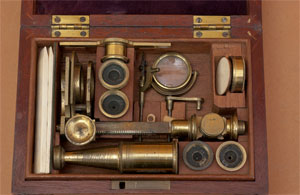Microscope No. 170 is a Gould-style instrument mounted on a mahogany case. While slightly larger that typical Gould microscopes, it is typical in that the tapered microscope body screws into a cantilevered support arm, which is itself supported on a rectangular brass pillar. The pillar is toothed and functions as the rack in the rack & pinion focus mechanism. The microscope has two stage accessories, a forceps and a Bull's eye lens, and comes with two bone sample slides. The optics of the microscope is a three-lens system with a Ramsden eyepiece, field lens and single objective lens. The microscope is 26cm tall.
Philip Carpenter (1776–1833) was a maker of scientific instruments in London between 1808 and his death. His firm was well known as a manufacturer of fine lenses, including achromatic lenses some of which were reputed to have been sold to Dollond. The original location of the shop was on Birmingham street, but when the firm became too large for this location they moved to New Street. During that period the firm became famous for the manufacture of two popular optical devices: the kaleidoscope and the Magic Lantern. In that era lantern slides were entirely hand-painted, and when Carpenter invented a method of mass producing lantern slides his company expanded greatly. This necessitated another move, and this time it was to Regent Street; the location where this microscope was made. In addition to moving the firm Carpenter also opened a public gallery and shop called "the Microcosm." He worked in his shop at this location until his death in 1833. After Philip's death his sister Mary took over the firm along with her husband William Westley. Soon thereafter (1835) firm changed its name to "Carpenter & Westley". Their manufacture of scientific instruments gradually decreased into the1850s until finally the firm of Carpenter & Westley evolved entirely into sales. At that time the manufacture of instruments was done by the firm of Negretti and Zambra until Carpenter & Westley closed shop permanently in 1914.








